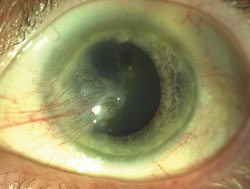Conjunctival autograft transplantation may prevent pterygium recurrence
The technique is also an economical option for the surgical management of pterygium.
 Thomas John |
Pterygium is a usually benign growth of the conjunctiva that extends from the nasal side of the sclera. It can involve the central cornea, thus compromising vision and cosmetic appearance of the involved eye. It is more common in men and has been thought to be caused by ultraviolet light (such as sunlight) exposure, low humidity and dust. Pterygia consist of elastotic degeneration of collagen along with fibrovascular proliferation. The neck of the pterygium connects the advancing head to the body of the pterygium. Recurrent pterygium can be a management challenge as compared to primary pterygium.
Various surgical techniques exist for the management of pterygium. Conjunctival autografting has generally been demonstrated to be superior to amniotic membrane transplantation, especially when dealing with recurrent pterygium. It is also more economical, only requiring a short additional surgical time when combined with fibrin glue application.
In this column, Dr. Kenyon describes his surgical technique of pterygium excision with conjunctival autograft transplantation, detailing the method that was developed at the Massachusetts Eye and Ear Infirmary 3 decades ago.
Thomas John, MD
OSN Surgical Maneuvers Editor
 Kenneth R. Kenyon |
Indications for the surgical management of pterygium are:
- Chronic inflammation and/or irritation, not relieved by medical therapy.
- Pterygium progression to threaten visual axis.
- Decreased vision due to pterygium involvement of the visual axis and/or induced astigmatism.
Surgical technique
Anesthesia may be topical tetracaine supplemented with subconjunctival lidocaine or, alternatively, peri- or retrobulbar anesthesia may be utilized, especially for recurrent cases. General anesthesia is seldom indicated. A limbal traction suture (8-0 Vicryl) is placed at the opposite limbus (eg, temporal if the pterygium is nasal), and the globe is rotated to maximally expose the pterygium (Figure 1).
Using a disposable low-temp cautery, six to eight spots are placed to delineate the body of the pterygium and adjacent tissue (often including the semilunar fold) to be excised. This is of great benefit because the surgeon can literally “connect the dots” and be certain that exactly the appropriate tissue has been removed (Figure 1). Grasping the pterygium head with 0.3 Castroviejo forceps, the cap is then dissected by probing with dry surgical sponges (Weck-Cel, Medtronic), scraping with a crescent or scarifier blade held perpendicularly to the corneal surface, and then avulsing and/or stripping the corneal portion solely by blunt technique. It is important to smooth the surface of the cornea and adjacent limbus with simple scraping with the perpendicularly oriented blade. A manual or motorized diamond burr may also be utilized for this purpose. Undermine the pterygium body with spring-action Westcott scissors, taking care to identify the rectus muscle. This muscle often becomes enmeshed in scar tissue, especially in recurrent cases, and disguises its identity, placing it at risk of being damaged or even severed unless extreme caution is exercised during the dissection. Only when the rectus muscle is clearly identified (with a traction suture or muscle hook) and cleanly dissected can the adjacent conjunctiva, Tenon’s tissue and scar tissue be excised without risk.
In approaching the medial canthus while dissecting prolapsed orbital fat, caution must be exercised to avoid severing blood vessels, which can be extremely difficult to cauterize. Should such deep bleeders that defy visualization and cauterization be encountered, then cut the triangular head from a cellulose surgical sponge and stuff this into the recess between the rectus and the plica. Definitive hemostasis can subsequently be obtained if necessary by rapidly with drawing the sponge and either performing cauterization or dripping the two-part fibrin glue into the depth of the wound to produce an adhesive seal. Once the bare scleral area is defined, measure the resultant conjunctival defect with calipers. The use of mitomycin C 0.02% is rarely required (in fewer than 5% of cases), such as in recurrences or in an extremely inflamed pterygium in a high-recurrence risk patient. In these situations, small surgical sponge segments are soaked in MMC and placed in the fornix recesses beneath the cut margins of the conjunctiva, avoiding exposure to the bare sclera and rectus muscle. After 2 to 3 minutes, the sponges are removed and the surgical field is copiously irrigated (with at least 15 mL of balanced salt solution).
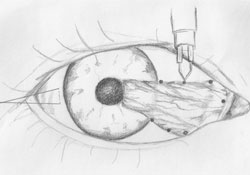 Figure 1. Schematic representation of conjunctival autograft surgical technique. A limbal traction suture (8-0 Vicryl) externally rotates the eye to maximally expose the pterygium. A disposable low-temp cautery is used to delineate the area of conjunctiva, including the semilunar fold, to be excised. |
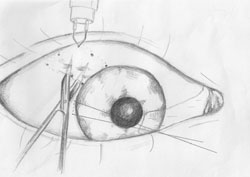 Figure 2. Following pterygium excision, the eye is rotated down and in to expose the superior temporal bulbar conjunctiva. Cautery spots define the area of the conjunctival autograft. Westcott scissors are used to dissect the conjunctiva as thinly as possible from the underlying Tenon’s tissue. The graft is excised with the cautery marks within the graft margins to assist with proper orientation and positioning at the transplantation site. The donor site is closed with a single diagonal suture of 8-0 Vicryl. Images: Kenyon KR, John
T |
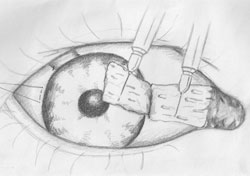 Figure 3. The conjunctival graft is appropriately positioned in the exposed scleral bed. If desired, two Vicryl sutures are placed to properly secure the medial margins 1 mm to 2 mm posterior to the limbus. The graft is then turned centrally to overlie the cornea, thereby exposing the stromal surface of the graft so that the more viscous sealer protein and aprotinin component of the fibrin adhesive can be applied to the graft stroma while the less viscous thrombin component is applied over the sclera and rectus muscle. |
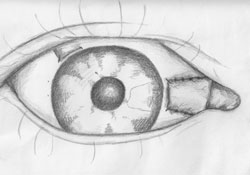 Figure 4. The conjunctival graft is turned and held in position to cover the entire scleral bed. If apposition to close the defect between the graft margin and caruncle is not adequate, then additional 8-0 Vicryl sutures can be placed, as this closure is important to prevent recurrence. |
|
|
|
|
Figure 5. Clinical photographs showing a
primary pterygium involving the visual axis (left) and the postoperative
appearance after pterygium excision with conjunctival autograft (right).
|
|
To harvest the conjunctival autograft, turn the globe down and in (with the traction suture), thereby exposing the superotemporal bulbar conjunctiva (Figure 2). Using the calipers, measure an area on the conjunctival surface sufficient to cover the exposed sclera and rectus muscle, and mark the perimeter with about six cautery spots. Excise the graft using Westcott scissors, first performing a radial conjunctival incision, then separate conjunctiva from Tenon’s tissue, and finally complete excision with cautery marks within the graft margins. Injection of minimal anesthetic or balanced salt solution into the donor conjunctival area to balloon the tissue may be helpful to create as thin a graft as possible, and the cautery marks help proper tissue orientation. Close the donor site with a single diagonal 8-0 Vicryl suture.
Return the eye to maximal abduction, and orient the conjunctival autograft to cover the exposed sclera. The corneal edge of the graft should be 1 mm posterior to the limbus, and two 8-0 Vicryl sutures may be placed to secure the central margin of the graft. The peripheral margin of the graft is then grasped with two forceps and is reflected to overlie the cornea with its stromal surface exposed (Figure 3). Fibrin adhesive components are then applied. The more viscous sealer protein with aprotinin is applied on the graft stromal surface, and the thinner thrombin is applied on the bare sclera. The graft is then inverted to cover the area of exposed sclera (Figure 4). Additional 8-0 Vicryl sutures may be used to secure the corners of the graft. If fibrin adhesive is not available or affordable, then the conjunctival graft can be entirely secured with a total of six sutures of 8-0 Vicryl. This only adds about 5 minutes to the total operating time. The limbal traction suture is then removed, and especially if the corneal epithelial defect is extensive, a standard-size bandage soft contact lens is applied along with topical antibiotic, corticosteroid, NSAID and an overnight patch. Adequate systemic analgesia (eg, oxycodone-acetaminophen 5-325 mg or acetaminophen-codeine 30 mg) should be provided for the first 24 to 48 hours. Utilizing this straightforward and long-utlilized technique, surgical success rates of 95%, as defined by no recurrence, improved comfort, cosmesis and extraocular movement, are routine (Figure 5). Thus, more complex and/or costly approaches such as amnion membrane transplantation are reserved for the rarely encountered more complex case.
References:
- Kenyon KR, Wagoner MD, Hettinger ME. Conjunctival autograft transplantation for advanced and recurrent pterygium. Ophthalmol. 1985;92(11):1461-1470.
- Nieuwendaal CP, van der Meulen IJ, Mourits M, Lapid-Gortzak R. Long-term follow-u of pterygium surgery using a conjunctival autograft and tissucol [published online ahead of print Sept. 20, 2010]. Cornea. doi:10.1097/ICO.0b013e3181dea7f0.
- de Wit D, Athanasiadis I, Sharma A, Moore J. Sutureless and glue-free conjunctival autograft in pterygium surgery: a case series. Eye (Lond). 2010;24(9):1474-1477.
- Thomas John, MD, OSN Cornea/External Disease Board Member, is a clinical associate professor at Loyola University Chicago and is in private practice in Tinley Park and Oak Lawn, Ill. He can be reached at 708-429-2223; e-mail: tjcornea@gmail.com.
- Kenneth R. Kenyon, MD, OSN Cornea/External Disease Editor Emeritus, can be reached at Cornea Consultants International and Eye Health Vision Centers, 51 State Road, Dartmouth, MA 02747; 508-994-1400; e-mail: kenrkenyon@cs.com.

